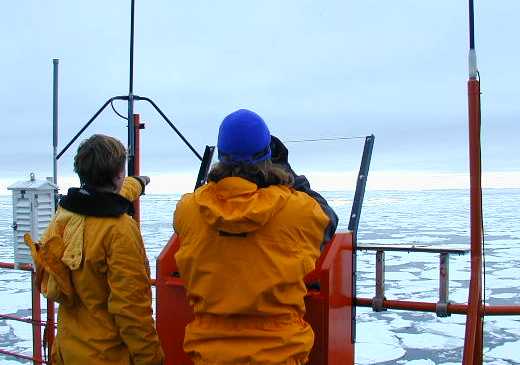 |
Southern Ocean
Cetacean Environment Program (SOCEP)
|
 |
The Southern Ocean Cetacean Environment
Program (SOCEP) is one program within a multidisciplinary collaborative effort
that has been initiated to monitor the dynamics of populations of Southern
Ocean fauna, in order to be able to detect perturbations of the marine ecosystem
through climate change and other large scale effects, human-induced or otherwise.
The biological components of this scheme are linked to the collection of oceanographic
and atmospheric data, which allow unprecedented insights into the functioning
of the Antarctic and Southern Ocean marine ecosystems.
Click here for some
sightings thus far...
Click here to see
the Minke Skeleton
The cetacean component of the program is
designed for long term monitoring of cetacean sightings on marine science voyages.
These data are part of a unified program to understand cetacean distribution,
abundance, and ecology which can be used by the International Whaling Commission
and other marine management bodies (e.g. CCAMLR, and SO Globec) to make informed
and effective management decisions relating to cetaceans and their prey in the
Southern Ocean Ecosystem.
On V4 there are 4 WHALOS conducting surveys
from the flying bridge and bridge. All sightings are recorded with a suite of
environmental and behavioral observations that can then be linked with the ship's
data for the time of each sighting. Both video and still cameras are used to
capture ice conditions and behavior of animals with regards to the approaching
ship. Your WHALOS are:
| Ari S. Friedlaender (Team Leader):
Ari is a graduate student at the University of North Carolina at Wilmington.
His research focuses on bottlenose dolphin conservation, and using the spatial
and temporal distribution of stranded animals to help elucidate stock structure
and generate appropriate management strategies. Ari is also involved in
several survey efforts to quantify and understand dolphin-gillnet fishery
interactions in North Carolina. This is Ari's 3rd ANARE voyage to Antarctica.
In preparation for his next marathon, Ari is calculating how many laps of
the heli deck equates to 26.2 miles. |
|
| Bec Donaldson: Bec is based at
the vet school at Murdoch Uni in WA, researching the social behaviour and
behavioural ecology of the bottlenose dolphins around Perth. She works part-time
teaching Aboriginal students, driving trucks for army reserves, and writing
about wildlife for a travel book series. |
|
| Victor M. Peddemors: Dr. Vic
Peddemors is a marine apex predator specialist presently employed by the
Natal Sharks Board in KwaZulu-Natal, South Africa. Over the past 16 years,
his research interest has covered a wide array of fields; however, primarily
revolves around ecological affects on animal behaviour, distribution and
abundance. As such, Vic was invited to participate on V4 as part of the
SOCEP aim of co-operative research within the southern hemisphere. Being
a tropical creature, Vic is acclimatizing slowly to the Antarctic environment.
|
|
| Bec Pirzl: Bec has
worked on marine mammal and seabird conservation with Environment Australia
since 1995, with a focus on addressing management issues for the protection
of whales and dolphins. She has been involved in a number of cetacean research
projects and this is her second Antarctic voyage. A kite flying fanatic,
Bec is awaiting the perfect polar gale. |
|
Click here for some
sightings thus far...
Click here to see
the Minke Skeleton
click on
"Tim the Penguin" to return to Antarctica 1999-2000 Page
